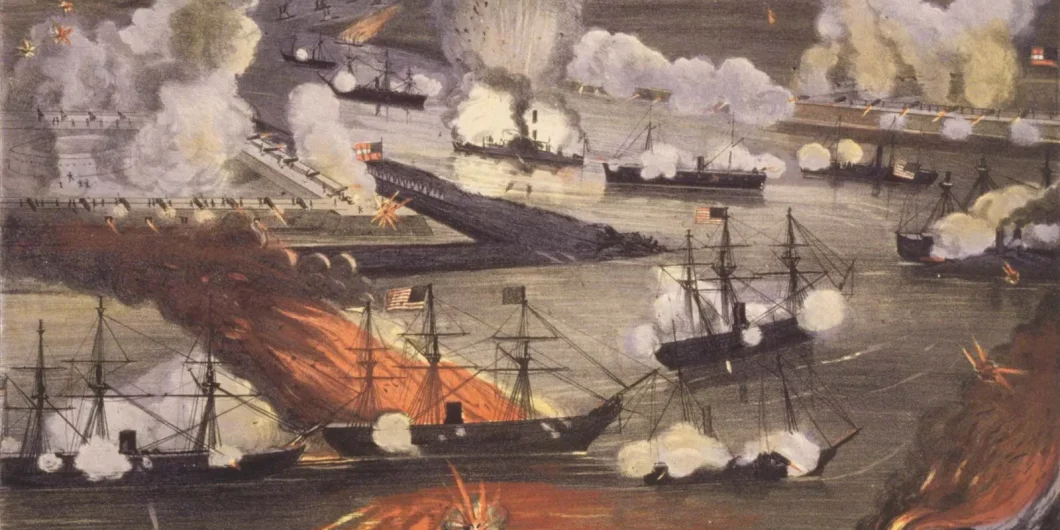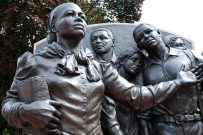The US Navy from Sail to Steam
Naval history typically evokes battles at sea and other heroic episodes. Lord Nelson’s attack on the French and Spanish fleets off Cape Trafalgar in 1805 that ended with his own death amidst triumph is a famous example. Americans might recall John Paul Jones’s defiant reply that he had “not yet begun to fight” when challenged to surrender in 1779 while his ship fought HMS Serapis with masts entangled. Dramatic events that draw attention comprise only part of a larger story about war at sea. The institutional development, planning, and professional ethos behind naval operations provide the context that made famous victories possible. Bringing those factors into the picture gives a fuller view of how major events came to pass and why they matter. It also sheds light on current debates about readiness and security policy by showing how peacetime efforts shape wartime effectiveness.
Claude Berube’s On Wide Seas: The US Navy in the Jacksonian Era explores trends during a decade that lacked conflicts on the scale of periods before and afterward. Early 19th-century campaigns against the Barbary Pirates and subsequently Britain in the War of 1812 marked a heroic period of American naval history that closed the age of sail. Later, both the Mexican War and Civil War involved maritime operations of a larger scale that used new technologies including steam propulsion. The landings at Veracruz in 1847 projected American power overseas with an amphibious operation not matched until Gallipoli during World War I. The peacetime changes Berube traces between those two eras explain much about the navy’s institutional development. Andrew Jackson’s presidency bridged the transition from sail to steam during this period that saw America through much larger shifts.
An Unlikely Proponent
Jackson, the backcountry lawyer who built his political career in Tennessee and the scourge of Eastern commercial elites who formed the navy’s main domestic constituency, seems an unlikely figure to improve the navy. Indeed, he won fame as a general by opening the frontier of the Old Southwest in wars against Indians and the British that secured present-day Alabama and Mississippi for settlement. Jacksonian Democracy’s valorization of universal male suffrage and government accountability to the popular will rest on widespread ownership of land that looked to westward expansion rather than maritime commerce. Berube makes a strong case, however, that Jackson appreciated sea power’s importance to the United States.
Traveling to his inauguration by steamboat highlighted both an evolving piece of naval technology and the importance of water communication. Jackson appreciated what steam-powered vessels meant for a country whose river networks linked farms and towns with coastal ports that sent exports abroad. He also knew how the British had used those rivers to attack the American interior. Jackson had been a child in South Carolina during the Revolutionary War when the Royal Navy facilitated the capture of Charleston, one of the greatest defeats in American history, which led directly to his mother’s death. Later in the War of 1812, he relied on naval cooperation to defeat the British at New Orleans. The navy provided the United States a first line of defense along vulnerable coasts. Jackson also saw how it projected force beyond American shores to defend growing commerce and buttress diplomacy. Even without the foreign travel or personal experience at sea that earlier presidents enjoyed, he understood the importance of a navy to the nation.
The Jacksonian Program
Berube traces Jackson’s thinking as much through his actions as by his written or spoken words. The fact that Jackson, a vindictive man who cherished resentments, continued the naval expansion program begun by John Quincy Adams, his predecessor and bitter rival, says much. Although Jackson’s inaugural address gave few words to the navy, it set a lasting policy with a commitment to a peacetime increase and a role beyond coastal defense. The protection of commerce required an American presence far from native shores that would only grow with more trade. Jackson struck a patriotic note evoking the “fame in arms” the US Navy had earned in the past and declared that even with a national militia as the bulwark of defense, prudence dictated “the introduction of progressive improvements in the discipline and science of both branches of our military service.” Innovation oriented to current trends and future challenges would uphold a proud tradition.
Jackson appointed political allies to direct the Navy Department, but they had the legislative and administrative experience to manage it effectively. Investigating its accounts laid the basis for further steps. He increased the navy budget by 270% in eight years. Much of that went to critical infrastructure, including the United States’ first naval dry docks and other expanded maintenance facilities. The investment enabled the navy to deploy larger forces when needed by bringing ships under construction or repair into service. A Navy Yard at Pensacola helped secure the Gulf Coast while another at Charleston made covering regions below the Chesapeake easier than before. Jackson oversaw the completion and refurbishment of larger warships, but also introduced steam vessels and built the sloops and schooners which Berube calls the backbone of the fleet. Those vessels could maintain a regular presence in American waters more easily than frigates which were costly to man and operate. They also supported operations by distant squadrons and extended the navy’s reach.
Naval efforts to protect Americans in the Falkland Islands and Sumatra indicated a commitment to global operations. In the first case, American ships backed diplomatic efforts, including support for Britain’s claim to the islands as more likely to secure them for peaceful use by other nations. In Sumatra, the American commander exceeded instructions by inflicting reprisals before demanding compensation for damages. Jackson preferred diplomacy to war despite his reputation for belligerence, and these episodes highlight his insistence on promoting trade overseas and defending it. Earlier operations in the Mediterranean had served established commerce which had been relatively close to the Eastern Seaboard, but the United States under Jackson increasingly opened new, more distant markets in Asia and the Pacific. “No previous president,” Berube writes, “had envisioned the extent of naval service as Jackson did during his administration.”
Questions about readiness, force structure, and fostering an effective naval professional culture during Jackson’s era resonate today.
Policing the seas went alongside opening distant regions to trade. Governments increasingly enforced order on territories they claimed lest others seize control as the French did in Algeria. Still, weak or failed states remained a phenomenon. The United States continued to hunt pirates in the Caribbean and monitor unrest in Texas to protect American coastlines that were distant from population centers. Mexico’s turbulent internal politics which threatened to cross borders or draw foreign intervention made it a concern. Stands of live oak for shipbuilding on the Gulf of Mexico faced illegal logging for the valuable timber. By maintaining a presence in these and other places, the US navy gained vital experience that raised its effectiveness.
The Seminole War in Florida drew the navy and marines into river operations and led to cooperation with the army and coastal patrols. Marines fighting ashore faced different challenges from the shipboard service and developed a distinct ethos. Deploying and maintaining steam vessels against the Seminoles marked a turning point in the navy’s development that highlights its adaptability. Lessons learned here carried into later conflicts.
“Maritime Destiny”
Jackson played little direct role in the navy’s intellectual culture beyond raising pay and funding institutional reforms, though Berube notes the interest he took in court martials. Those proceedings were an essential part of discipline and professional accountability. Posting chaplains aboard ships also met concerns over discipline among crews. Other changes fostered engagement with naval history, science, and technological developments. Better training for officers ashore replaced the customary apprenticeship at sea. Lyceums and publications continued professional education while the navy’s culture encouraged intellectual engagement among officers. Many, like Matthew Fontaine Maury, a pioneering oceanographer, published notable books, while others contributed to journals. Private correspondence and friendships complemented publications and institutional structures as avenues for exchanging military knowledge that shaped the officer corps’ ethos. Leading figures of later decades, including the Civil War era, had their professional start in the navy in the 1830s.
Popular enthusiasm for the sea during these years set the context for these trends. James Fenimore Cooper, a navy veteran, wrote naval history along with sea stories that promoted a fictional genre Herman Melville took up later. Cooper aimed consciously to promote American literature as more than a derivative echo of Europe’s. His and other works introduced the navy and its environment to a growing readership. They built a constituency in American popular culture by bridging past heroics and a new generation’s ambitions. Berube rightly stresses the relationship between naval officers and literary figures in shaping public sensibilities. America looked beyond its shores to the seas as much as to the western frontier with the navy being an important part of its story.
Indeed, the novelist Joseph Hart wrote in 1843 that “supremacy on the ocean is America’s great national destiny.” Noting that Hart coined the phrase “Maritime Destiny” a decade before the more recognized term “Manifest Destiny,” Berube cites it as evidence that Americans looked beyond their shores and recognized the navy’s importance for protecting global commercial interests. The United States, like other continental powers such as Russia and Germany, had a different focus than maritime states like Britain, the Dutch Republic, and Venice which were dependent on seaborne commerce. For the United States, westward expansion over the plains and Rockies, along with developing the Mississippi watershed, preoccupied the nation and exerted a powerful draw of resources as the 19th century unfolded, but the sea and its importance for trade had a pull of its own that never quite faded. Alfred Thayer Mahan and Theodore Roosevelt made a case for the latter that did much to make Maritime Destiny a reality in the 20th century.
Berube’s fine history shows the value of looking back to a neglected period on its own terms while pointing avenues for future research. Scholars and enthusiasts alike will find it a rewarding study that develops larger themes in naval history. Questions about readiness, force structure, and fostering an effective naval professional culture during Jackson’s era also resonate today. So does the way preoccupations ashore draw focus and resources away from maritime considerations. Today’s context sharply differs from that era but reflecting on historical experience helps bring present challenges into better perspective. It shows that administration and institutional development produce their own drama, albeit of a different kind than the famous sea battles that capture the imagination more readily.



